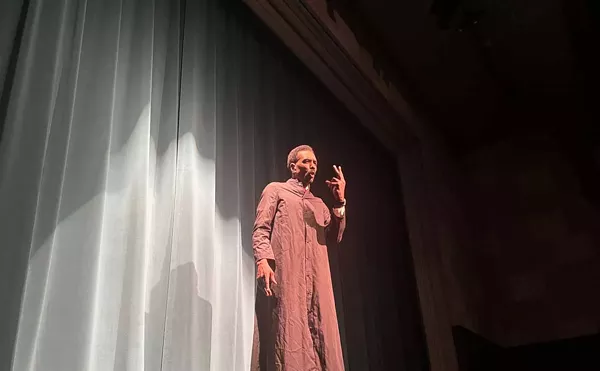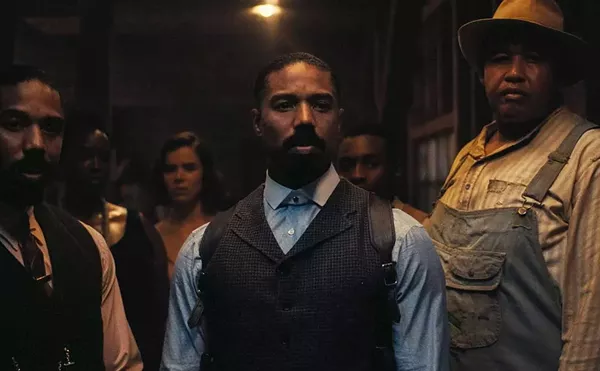
Audio By Carbonatix
[
{
"name": "GPT - Leaderboard - Inline - Content",
"component": "35519556",
"insertPoint": "5th",
"startingPoint": "3",
"requiredCountToDisplay": "3",
"maxInsertions": 100,
"adList": [
{
"adPreset": "LeaderboardInline"
}
]
}
]
Going into Bob Sestok’s studio while waiting for him to return from up North was a resolution of something that had been worrying me for some time. His wife was a little uneasy about letting me see the new work while he wasn’t there, but she said, “I don’t think he’ll mind if you look.”
When the lights went on I felt relieved, as if all of my hunches were right. On the floor were two new unstretched paintings; on the wall two more were visible and a couple hidden. The drips, blobs and swatches of color of the large paintings lying on the floor sucked the light right out of the abundant overhead bulbs. Their energy and direct sincerity was wonderful. I looked at one on the wall and said, “It’s like a big beautiful gift.” His wife said, “I’m thinking of that big, fuzzy, decorative coat on that woman in the Klimt painting.”
She was right. The painting was, as poet Charles Olson once said about reality’s appearance, “a coat of wonder.”
After a recent look at “Obstacles,” the new series of Sestok’s paintings at Cass Cafe, there was something that bothered me. They didn’t seem to have the vitality, the contained but elusive excitement usually found in Sestok’s work, whether sculpture or painting. It didn’t bother me that they didn’t seem great — art doesn’t have to be great all the time. Art is about increasing the tools we have in our toolbox for working on the world and allowing new perceptions, and that’s what Sestok has done since his days in the Cass Corridor better than anyone.
As an artist he’s always been a problem-solver. He examines the materials he’s working with and allows the materials to work through him. It’s invention at its best. When Sestok recycled I-beams from old buildings in his sculptural work, he allowed the simple capital “I” shape to build strong, three-dimensional abstractions in the air — like the brushstrokes of Franz Kline paintings. When he worked with cast-iron pipe, the sculptures became whimsical arabesque cutouts that seriously played with positive and negative space. Once he even created a series of five magnificent wall reliefs with beer cans and other personal and public residuum, one of which (Meogeesic, 1978) is in Wayne State University’s Duffy collection. And in One by Two, a large painted mural that gave life to a downtown industrial warehouse, he employed a simple triangle shape to develop a stunning all-over-pattern painting that reinvented a classical African motif. Sestok was the quintessential Cass Corridor inventor.
But something was wrong. The large “Obstacles” paintings had all of the earmarks of significant work. A magically obsessive application of small punchy marks on the canvas, made probably with a palette knife, immediately built a pattern that resembled a fir tree forest. It was vintage Sestok.
Yet when I saw the new work in the studio, I realized that the real paintings in the Cass Cafe exhibition couldn’t be seen. At night the café is dark and moody. After I made a rare daytime visit to the venue when sunlight filled the room, the paintings in “Obstacles” came alive. Like the newer work still in the studio, they’re large and need gobs of light and breathing space around them to be seen, since they’re filled with nuanced color that models the forms that emerge.
With their jagged angularity and Gothic architectural look, the paintings in “Obstacles” are reminiscent of certain German Expressionist works of the early 20th century. Sestok has applied the thickly viscous paint with a palette knife (which is more like a clay worker’s tool) instead of a paintbrush. He lets the marks the tool makes find their own direction. The obsessive gesture of the knife — the “solution” to “painting” with a metal tool — ends up looking like a fir tree frond or fir branch. Their wonderful accumulation became 15 or so very large paintings with this all-over-pattern language.
If we’re looking for a subject or theme in Sestok’s work, it is veiled in this “obstacle” of not being able to see the forest through the trees. It’s about the feel and mood of our times. Indeed, each of the paintings allows illusions of depth and space and many lyrical narrative passages to emerge from within the maze of painted crosshatched marks. But to support their epic naturalism, they need a cathedral of light and space.
“Obstacles” will be up through mid-July at the Cass Cafe (4620 Cass Ave., Detroit; call 313-831-1400). A new series of Sestok’s paintings, entitled “Constant Variables,” will be shown along with the work of Sherry Hendrick at ZeitGeist Gallery in the fall.
Glen Mannisto writes about visual art for Metro Times. E-mail him at letters@metrotimes.com




